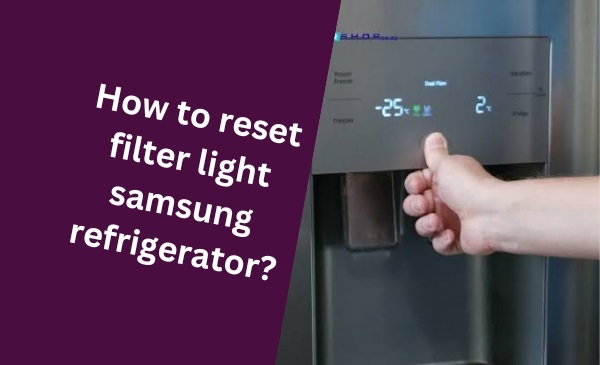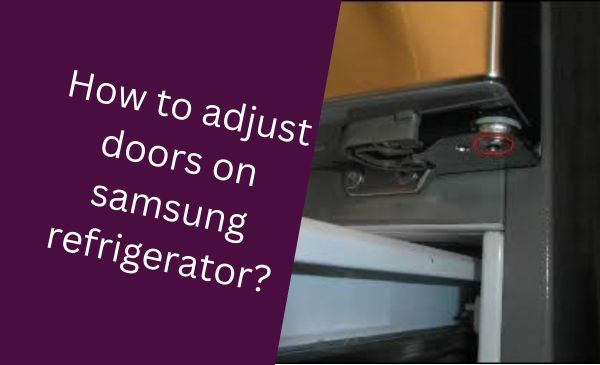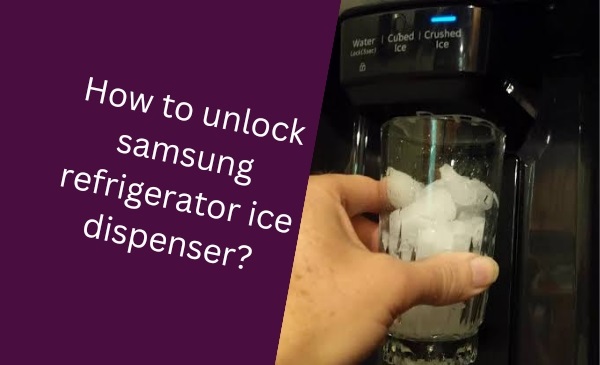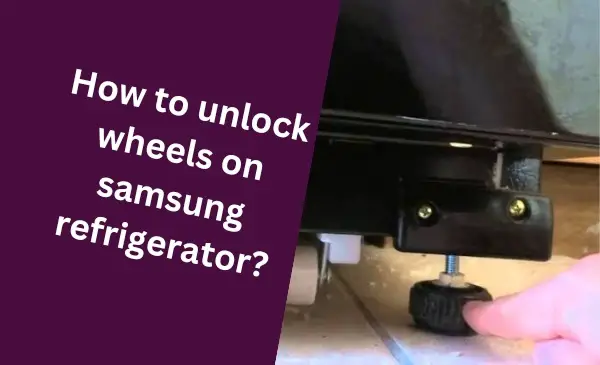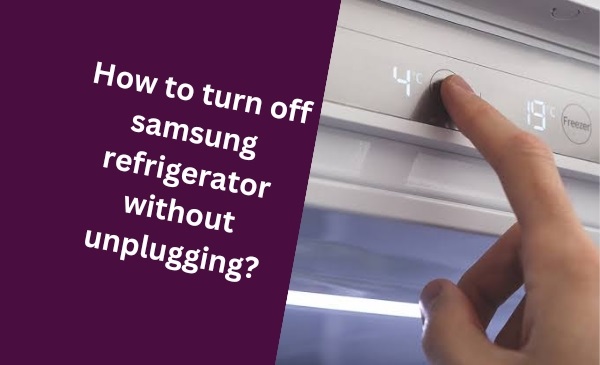Imagine you’re moving into a new home, and you need to move your Samsung refrigerator. It’s a big, heavy appliance, and you’re not sure where to start. Don’t worry, we’re here to help!
Moving a Samsung refrigerator can be a daunting task, but it’s important to do it carefully to avoid damaging the appliance or injuring yourself. There are a few key things to keep in mind when moving a Samsung refrigerator, such as:
- The weight: Samsung refrigerators can weigh upwards of 400 pounds, so it’s important to have help moving them.
- The size: Samsung refrigerators are also quite large, so you’ll need to make sure you have enough space to maneuver them in your new home.
- The features: Some Samsung refrigerators have features such as ice makers and water dispensers, which need to be disconnected before moving.
In this guide, we will walk you through the steps of how to move a Samsung refrigerator safely and efficiently.
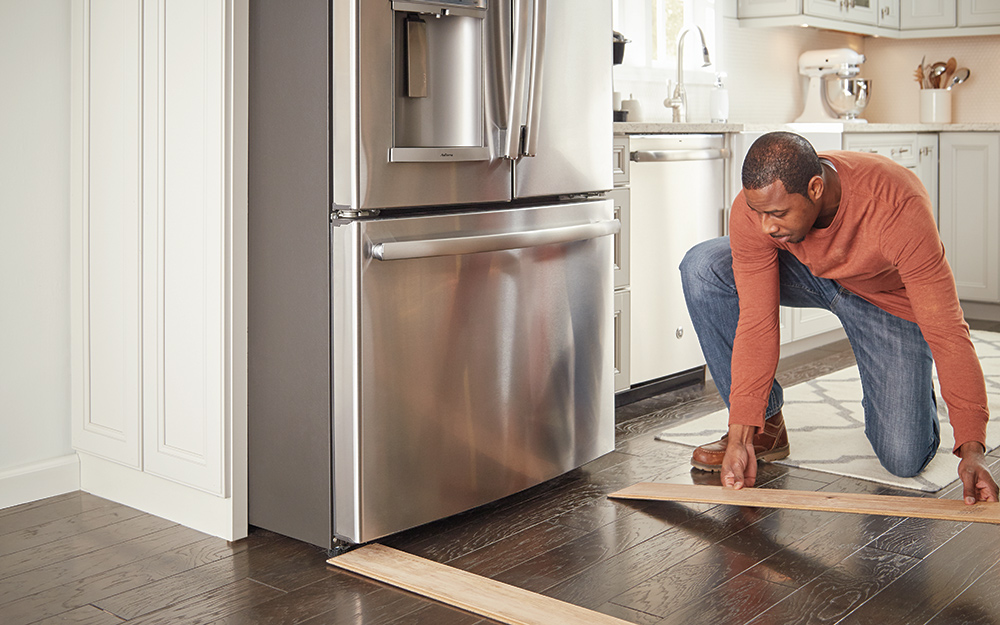
Credit: www.homedepot.com
Preparing For The Move
Moving a Samsung refrigerator can be a daunting task, but with the right preparation, it can be a smooth and hassle-free process. Taking some time to measure and evaluate your new space, gather the necessary tools and supplies, and empty and clean the refrigerator can make all the difference in ensuring a successful move.
In this section, we will guide you through each step in detail, providing you with valuable tips and techniques to make your moving experience a breeze.
Measure And Evaluate Your New Space
Before moving your Samsung refrigerator, it’s important to measure and evaluate the new space where it will be placed. This will help you determine if the refrigerator will fit comfortably and allow for proper ventilation. Start by measuring the doorways, hallways, and stairwells that the refrigerator needs to pass through. Write down the measurements, ensuring they are accurate and clear. Take note of any obstacles or tight spaces that may require additional maneuvering.
Next, measure the allocated space for the refrigerator in the new location. Take into account the dimensions of the refrigerator itself, including the width, depth, and height. Ensure that there is enough space for the refrigerator door to fully open without any restrictions. Consider any surrounding cabinets or walls that may also impact the positioning of the refrigerator. By carefully measuring and evaluating your new space, you can avoid any surprises or difficulties during the move.
Gather The Necessary Tools And Supplies
Having the right tools and supplies on hand is essential for a successful move of your Samsung refrigerator. Make sure to gather the following items before you begin:
- Tape measure
- Furniture dolly or hand truck
- Floor protection, such as furniture pads or cardboard
- Packing materials, such as bubble wrap or moving blankets
- Masking tape or labels for marking and securing parts
- Appliance straps or bungee cords for securing the refrigerator during transport
- Cleaning supplies, including mild detergent and water
- Towels or cloths for drying and wiping down the refrigerator
Having these tools and supplies readily available will save you time and effort during the move, ensuring the safety of your Samsung refrigerator and surrounding environment.
Emptying And Cleaning The Refrigerator
Before moving your Samsung refrigerator, it’s crucial to empty and clean its contents. Start by removing all food items and perishables from the refrigerator, and disposing of any expired or unusable items. Consider donating any unopened, non-perishable food items to a local food bank. Remove all shelves, drawers, and trays, ensuring they are securely wrapped and packed to prevent damage during transport.
Next, thoroughly clean the inside of the refrigerator using a mild detergent and water solution. Wipe down all surfaces, including the walls, shelves, and door compartments. Take extra care to clean any stains or spills, paying attention to corners and crevices. Finally, dry the refrigerator completely using towels or cloths, ensuring that no moisture is left behind.
By emptying and cleaning your Samsung refrigerator, you not only ensure the hygiene and freshness of your food but also minimize the risk of any odors or spills during the move.
Disconnecting And Preparing For Transportation
Moving a Samsung refrigerator can be a daunting task if not properly prepared. It’s crucial to disconnect and prepare your refrigerator before transportation to ensure its safety and avoid any damage. This guide will walk you through the necessary steps to disconnect and prepare your Samsung refrigerator for transportation.
Safely Turn Off The Power And Empty The Contents
Before you start disconnecting your refrigerator, it’s important to shut off the power supply to avoid any electrical hazards. Locate the power cord at the back of your refrigerator and unplug it from the power outlet. Make sure you keep the refrigerator door closed during this process to retain the cold temperature inside.
Once the power is disconnected, it’s time to empty the contents of your refrigerator. Remove all the food items, including perishable and non-perishable items. If possible, plan your move well in advance to consume or donate perishable items to avoid wastage. Dispose of any expired or spoiled food items before packing.
Disconnect And Secure The Water Supply Line
If your Samsung refrigerator is equipped with a water dispenser or ice maker, it will have a water supply line connected to it. Before moving, you need to disconnect and secure the water supply line to avoid any leaks or damage.
Start by locating the water supply valve behind the refrigerator. Turn it clockwise to shut off the water flow. Once the water flow is stopped, carefully disconnect the water supply line from the valve. You may need a wrench or pliers to loosen the connections.
After disconnecting the water supply line, make sure to securely fasten it to the back of the refrigerator. You can use zip ties or tape to keep it in place and prevent any tangling or accidents during transportation.
Remove The Shelves, Drawers, And Accessories
To ensure the safety of the shelves, drawers, and accessories inside your Samsung refrigerator, it’s best to remove them before moving. Start by taking out all the removable shelves, drawers, and accessories. Please place them in a secure location or wrap them individually with bubble wrap to prevent any damage during transportation.
Remember to label each item or take a picture of their original positions to ease the reassembly process when setting up your refrigerator in the new location.
Secure The Doors And Protect The Exterior
Now that you have disconnected the power, emptied the contents, and removed the shelves and accessories, it’s time to secure the doors and protect the exterior of your Samsung refrigerator.
Start by taping the doors shut with strong packing tape. This will prevent them from accidentally opening during transportation and causing damage to the hinges or other parts.
Next, cover the entire refrigerator with moving blankets or towels to protect its exterior from scratches or any external impact. Secure the blankets or towels with additional packing tape to hold them in place.
By following these steps to safely disconnect and prepare your Samsung refrigerator for transportation, you can ensure its safe arrival to your new location and minimize the risk of any damages.
Moving The Refrigerator
Moving a Samsung refrigerator can be a challenging task, but with proper planning and execution, it can be accomplished smoothly and safely. In this section, we will discuss important steps to consider when moving your refrigerator to ensure a hassle-free experience.
Enlist Help And Ensure Proper Lifting Techniques
Moving a refrigerator is not a job that should be done alone. It’s crucial to enlist the help of at least one or two strong individuals to assist you. This not only ensures that the refrigerator is moved safely but also minimizes the risk of injuries.
When lifting the refrigerator, it’s important to use proper lifting techniques to prevent strain and injuries. Make sure to bend your knees and lift with the strength of your legs instead of your back. Keep your back straight and hold onto the refrigerator from the bottom and sides for better stability.
Use Moving Equipment Or Sliders To Ease Transportation
Transporting a Samsung refrigerator can be made easier by using specialized moving equipment or sliders. Moving equipment such as a refrigerator dolly or hand truck will provide additional support and make it easier to maneuver the refrigerator. Sliders can also be used to slide the refrigerator smoothly across the floor, minimizing the effort required.
If you don’t have access to moving equipment, you can also use furniture sliders, old towels, or cardboard to create a makeshift sliding surface. Place these sliders or towels under the refrigerator’s feet to minimize friction and facilitate movement.
Navigate Stairs And Doorways Safely
When moving a refrigerator, it’s essential to navigate stairs and doorways safely to avoid any damage to the appliance or your surroundings. Before attempting to move the refrigerator, measure the doorways and staircases to ensure the appliance can fit through without any issues.
If the refrigerator is too wide to fit through a doorway, you may need to remove the refrigerator doors temporarily. Follow the manufacturer’s instructions on how to safely remove the doors and keep track of any screws or bolts that need to be reinstalled later.
Secure The Refrigerator In The Moving Vehicle
Once the refrigerator is ready to be loaded into the moving vehicle, it’s important to secure it properly to prevent any shifting or damage during transportation. Use strong straps or bungee cords to secure the refrigerator to the walls or tie-down points of the vehicle.
Avoid placing heavy items on top of the refrigerator as it may cause damage to the appliance. Make sure the refrigerator is placed in an upright position to avoid any potential leaks from the compressor oil.
By following these steps, you can ensure that your Samsung refrigerator is moved safely and securely to its new location. Remember to handle the appliance with care and seek professional help if necessary.
Setting Up The Refrigerator In The New Location
Once you have successfully moved your Samsung refrigerator to its new location, it’s time to set it up properly. This involves positioning and leveling the refrigerator, reconnecting the water supply line, allowing the refrigerator to settle and reach optimal temperature, and finally, restocking and organizing the refrigerator. Follow the steps below to ensure a smooth setup process.
Positioning And Leveling The Refrigerator
Proper positioning and leveling of your Samsung refrigerator is crucial. Follow these steps to ensure stability and functionality:
- Place the refrigerator in a spot with adequate space and ventilation. Maintain a minimum clearance of 2 inches on either side and 2.5 inches at the back.
- Use a level to check if the refrigerator is tilting. Adjust the leveling legs if necessary to ensure it is perfectly level from front to back and side to side.
Reconnecting The Water Supply Line
If your refrigerator has an ice and water dispenser, it’s essential to reconnect the water supply line. Here’s how:
- Locate the water supply valve behind the refrigerator or in the basement.
- Turn the valve clockwise to shut off the water supply.
- Connect the water supply line to the water valve on the back of the refrigerator. Use a wrench to tighten the connections.
- Turn the water supply valve counterclockwise to restore the water flow.
Allowing The Refrigerator To Settle And Reach Optimal Temperature
After positioning and reconnecting the water supply line, allow your Samsung refrigerator to settle and reach optimal temperature before loading it with food. Here’s what you need to do:
- Plug in the refrigerator and ensure it is turned on.
- Wait for at least 3 hours for the refrigerator to cool down and stabilize to its optimal temperature.
Restocking And Organizing The Refrigerator
With your refrigerator properly positioned, connected, and cooled, you can now start restocking and organizing your food. Follow these tips:
- Discard any expired or spoiled items from the previous location.
- Organize the fridge shelves and door compartments according to your preference, keeping frequently used items easily accessible.
- Use clear containers or bins to keep similar items together and maximize space.
- Avoid overcrowding the refrigerator to allow for optimal airflow and ensure efficient cooling.
Troubleshooting And Tips For A Successful Move
Moving can be a daunting task, especially when it involves delicate appliances like your Samsung refrigerator. To ensure a seamless and stress-free transition, proper troubleshooting and following essential tips are crucial. In this section, we discuss potential issues and complications that may arise during the move and provide valuable advice on maximizing energy efficiency post-move.
We also delve into routine maintenance and cleaning practices for optimal performance. Additionally, we highlight further assistance and support options available from Samsung.
Handling Potential Issues And Complications
Transporting a refrigerator requires careful handling to prevent damage and avoid potential issues that may arise during the move. Here are some tips to ensure a smooth transition:
- Secure the doors: Before moving your Samsung refrigerator, make sure to secure the doors properly using tape or bungee cords. This precautionary measure prevents any accidental opening during transportation.
- Empty and defrost: Empty the contents of the refrigerator and freezer compartments. Defrost the unit at least 24 hours before the move to prevent water leakage during transportation.
- Disconnect and secure: Disconnect the refrigerator from the power supply and secure any loose components, such as shelves or trays, inside the unit. Use tape or packing materials to keep them in place.
- Use proper moving equipment: Utilize a dolly or appliance hand truck to safely move the refrigerator. These equipment pieces distribute the weight evenly and help maneuver the appliance with ease.
Maximizing Energy Efficiency After The Move
Once your Samsung refrigerator is successfully relocated, it’s important to optimize its energy efficiency to keep your energy bills in check. Follow these tips:
- Allow for proper ventilation: Ensure that the refrigerator is positioned with sufficient space around it for adequate airflow. This allows the appliance to cool efficiently and reduces strain on the compressor.
- Set the temperature correctly: Check and adjust the temperature settings according to the manufacturer’s recommendations. Excessively low temperatures can waste energy, while higher temperatures compromise food preservation.
- Avoid frequent door opening: Limit the number of times you open the refrigerator door to maintain a consistent and optimal internal temperature.
- Check and replace seals: Inspect the door seals for any signs of wear or damage. Faulty seals can cause air leakage, leading to energy loss. Replace them promptly if necessary.
- Regularly clean condenser coils: Dust and debris accumulation on the condenser coils can hinder heat transfer, reducing energy efficiency. Clean the coils regularly to maintain optimal performance.
Routine Maintenance And Cleaning For Optimal Performance
Proper maintenance and cleaning of your Samsung refrigerator not only ensures optimal performance but also extends its lifespan. Follow these routine practices:
- Clean the interior: Regularly remove and clean shelves, drawers, and compartments using a mild detergent. Wipe away any spills or stains to maintain a hygienic environment for your food.
- Defrost and clean the freezer: Perform regular defrosting of the freezer to keep ice buildup at bay. Clean the freezer compartment with warm water and a non-abrasive cleaner to prevent unpleasant odors.
- Inspect and clean the water filter: If your Samsung refrigerator has a built-in water filter, check it periodically for clogs or contamination. Replace the filter as recommended by the manufacturer to ensure a clean and fresh water supply.
- Keep the exterior clean: Wipe the exterior surfaces of the refrigerator using a soft cloth and a mild cleaning solution. Avoid abrasive materials or harsh chemicals that can damage the appliance’s finish.
Further Assistance And Support From Samsung
If you encounter any issues or require additional assistance with your Samsung refrigerator, you can rely on the comprehensive support offered by Samsung. Contact their customer service hotline or visit their official website for troubleshooting guides, FAQs, and product manuals.
Frequently Asked Questions On How To Move Samsung Refrigerator
How Can I Move My Samsung Refrigerator Safely?
To move your Samsung refrigerator safely, start by emptying the contents and safely packaging any loose items. Next, defrost the refrigerator and remove any shelves or drawers that can be easily taken out. Make sure you secure the doors with moving straps or tape and use a dolly to transport the refrigerator.
Finally, take extra care while loading and unloading to prevent any damage.
Can I Lay My Samsung Refrigerator Down To Move It?
It is generally not recommended to lay your Samsung refrigerator down during transportation. This can cause damage to the compressor and cooling system. If you absolutely have to lay it down, make sure the refrigerator is unplugged at least 24 hours before and wait 24 hours after to plug it in again.
However, it’s best to transport it in an upright position to avoid any potential problems.
Should I Remove The Doors Of My Samsung Refrigerator To Move It?
Removing the doors of your Samsung refrigerator is not necessary for normal moves. However, if you encounter any doorways or stairwells that are too narrow to accommodate the refrigerator’s size, you may need to remove the doors. Follow the manufacturer’s instructions to safely remove the doors and keep the screws and bolts in a secure place.
Remember to properly reassemble the doors after moving.
Conclusion
Moving a Samsung refrigerator can be a manageable task when ensuring proper preparation and caution. By following the step-by-step guide provided in this blog post, you can safely and efficiently relocate your appliance without causing any damage or inconvenience. Remember to secure loose parts, disconnect the power supply, and utilize a dolly or help from others for easier maneuverability.
With these tips in mind, you’ll be on your way to a successful refrigerator move. Happy moving!
Hello Readers, I am Mechanic Shuvo, a seasoned refrigerator solution expert with over 11 years of hands-on experience in the field. Throughout my career, I've dedicated myself to understanding the ins and outs of refrigeration systems, honing my skills as a refrigerator mechanic. My passion for these appliances led me to create the website "refrigeratorsolutionsguide.com," where I aim to share my wealth of knowledge and expertise with others.
Over the years, I've encountered a wide range of refrigerator issues and have successfully resolved them all. From common problems like temperature fluctuations and strange noises to more complex technical issues, I've seen it all. Through my website, I hope to provide practical solutions, insightful tips, and guidance to help you keep your refrigerators running smoothly.


